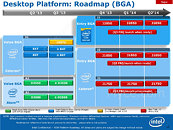- Joined
- Oct 9, 2007
- Messages
- 47,306 (7.52/day)
- Location
- Hyderabad, India
| System Name | RBMK-1000 |
|---|---|
| Processor | AMD Ryzen 7 5700G |
| Motherboard | ASUS ROG Strix B450-E Gaming |
| Cooling | DeepCool Gammax L240 V2 |
| Memory | 2x 8GB G.Skill Sniper X |
| Video Card(s) | Palit GeForce RTX 2080 SUPER GameRock |
| Storage | Western Digital Black NVMe 512GB |
| Display(s) | BenQ 1440p 60 Hz 27-inch |
| Case | Corsair Carbide 100R |
| Audio Device(s) | ASUS SupremeFX S1220A |
| Power Supply | Cooler Master MWE Gold 650W |
| Mouse | ASUS ROG Strix Impact |
| Keyboard | Gamdias Hermes E2 |
| Software | Windows 11 Pro |
Intel's first processors in the BGA (ball-grid array) package, arrive by the end of 2013, according to a leaked roadmap slide. Some of the first of these processors will span across entry-level market segments, covering the Celeron and Pentium brands. The term system-on-chip (SoC) better defines these chips than processors, as they completely integrate the processor as we know it, with the motherboard chipset. Motherboards with BGA processors come with the processors non-replaceable, and hard-wired to the board, with a stock fan-heatsink.
Intel's first SoCs for the desktop are based on the "BayTrail-D" silicon. These include the Celeron J1750, Celeron J1850, and Pentium J2850. Celeron J1750 is a dual-core part, with the CPU cores clocked at 2.41 GHz, GPU at 792 MHz, and a TDP rated at just 10W. Celeron J1850, on the other hand, is a quad-core part, with its CPU cores clocked at 2.00 GHz, and the same 792 MHz GPU. Pentium J2850 tops the series, being a quad-core part with CPU cores running at 2.41 GHz, and GPU at 792 MHz. Both these quad-core parts stick to 10W TDP. Being SoCs, these chips integrate connectivity otherwise handled by a PCH, into the processor package. According to an Intel roadmap slide, the three parts will spearhead Intel's BGA CPU lineup deep into 2014, at least as far as late-June.


Then there are the mainstream-thru-performance segments. These are chips based on the Haswell-GT3 package. Haswell GT3 is a quad-core Haswell silicon with a larger iGPU. This iGPU features double the number of execution units to conventional Haswell GT1/GT2 (40 EUs vs. 20 EUs); and a large L4 eDRAM cache. Among the first BGA performance-segment parts from Intel, are the Core i5-4570R, i5-4670R, and Core i7-4770R.
The i5-4570R features 2.70 GHz CPU clocks, 3.20 GHz Turbo Boost, 4 MB of L3 cache, Iris Pro 5200 graphics clocked at 1150 MHz, and 65W TDP. The i5-4670R ups that with 3.00 GHz CPU clocks, 3.70 GHz Turbo Boost, the same 4 MB of L3 cache, but faster Iris Pro graphics clocked at 1.30 GHz. Leading the pack is the Core i7-4770R, with 6 MB L3 cache, HyperThreading, 3.20 GHz CPU clocks, 3.90 GHz Turbo Boost, and the same 1.30 GHz graphics core.
View at TechPowerUp Main Site
Intel's first SoCs for the desktop are based on the "BayTrail-D" silicon. These include the Celeron J1750, Celeron J1850, and Pentium J2850. Celeron J1750 is a dual-core part, with the CPU cores clocked at 2.41 GHz, GPU at 792 MHz, and a TDP rated at just 10W. Celeron J1850, on the other hand, is a quad-core part, with its CPU cores clocked at 2.00 GHz, and the same 792 MHz GPU. Pentium J2850 tops the series, being a quad-core part with CPU cores running at 2.41 GHz, and GPU at 792 MHz. Both these quad-core parts stick to 10W TDP. Being SoCs, these chips integrate connectivity otherwise handled by a PCH, into the processor package. According to an Intel roadmap slide, the three parts will spearhead Intel's BGA CPU lineup deep into 2014, at least as far as late-June.


Then there are the mainstream-thru-performance segments. These are chips based on the Haswell-GT3 package. Haswell GT3 is a quad-core Haswell silicon with a larger iGPU. This iGPU features double the number of execution units to conventional Haswell GT1/GT2 (40 EUs vs. 20 EUs); and a large L4 eDRAM cache. Among the first BGA performance-segment parts from Intel, are the Core i5-4570R, i5-4670R, and Core i7-4770R.
The i5-4570R features 2.70 GHz CPU clocks, 3.20 GHz Turbo Boost, 4 MB of L3 cache, Iris Pro 5200 graphics clocked at 1150 MHz, and 65W TDP. The i5-4670R ups that with 3.00 GHz CPU clocks, 3.70 GHz Turbo Boost, the same 4 MB of L3 cache, but faster Iris Pro graphics clocked at 1.30 GHz. Leading the pack is the Core i7-4770R, with 6 MB L3 cache, HyperThreading, 3.20 GHz CPU clocks, 3.90 GHz Turbo Boost, and the same 1.30 GHz graphics core.
View at TechPowerUp Main Site
Last edited:






